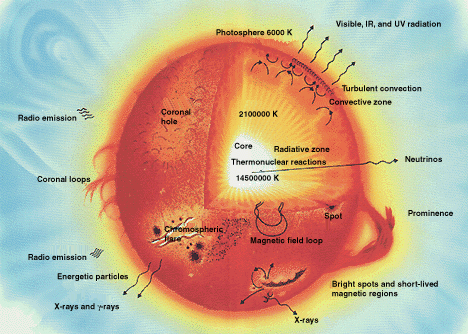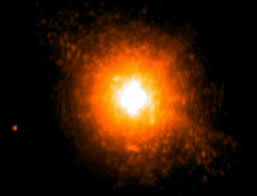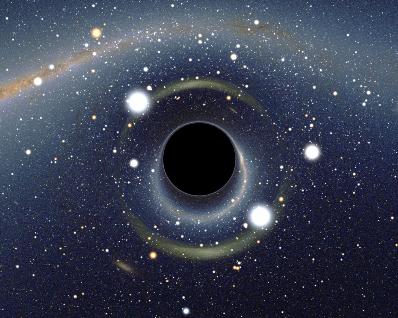A Star's Life Cycle
By Cynthia L.
Like us, a star, such as our big red sun, has a life cycle it does through. This cycle, unlike us, takes billions of years. Just like us, a star has to be "born" from something called a nebula.

 The crab nebula. Picture at: http://www.networlddirectory.com/images/blogs/crab-nebula-552300.jpg
The crab nebula. Picture at: http://www.networlddirectory.com/images/blogs/crab-nebula-552300.jpg
A Star is Born
Stars are created from nebulas, which is a cloud of dust and gas composed primarily of hydrogen (97%) and helium (3%). Within a nebula, there are various places with gravitational force which causes the gas and dust to "clump" together. As "clumps" gain more mass, the force of gravity increases. This is due to Newton's law of universal gravitation. Newton's law states that Adding atoms to the center of a protostar, which is a large medium that forms from by concentration of the gas of a large molecular cloud and the early stage of a star's life, is a process astronomers call accretion. Because numerous reactions occur within the mass of forming star material, a protostar is not very stable. To achiece life as a star, the protostar will need to achieve and maintain equilibrium, which is balance between gravity that pulls the atoms towards the center and gass pressure puching heat and light away from the center. When a star can no longer maintain equilibrium it dies and maintaining it isn't easy.
The process:
1. Gravity pulls gas and dust inward toward the core.
2. Inside the core, temperature increases as gas atoms collisions increase.
3. density of the core increases as more atoms try to share the same space.
4. Gas pressure increases as atomic collisions and density (atom/space) increase.
5. The protostar's gas pressure resists the collapse of the nebula.
6. when gas pressure= gravity, the protostar has reached equilibrium and accretion stops.
What allows a protostar to reach equilibrium? Gravity must star constant and gas pressure must equal gravity. What maintains gas pressure is a very not temperature so atoms keep colliding and density.
At this point, there are 2 options for a protostar:
1. If a critical temperature in the core of a protostar is not reached, it ends up a brown dwarf. This mass never makes "star status."
2. If a critical temperature in the core of a protostar is reached, then nuclear fusion begins. The birth of a star is identified at the moment it begins fusing hydrogen in the core.

A star. http://www.scitech.ac.uk/resources/image/Star.jpg
What is a Star?
A star is basically a big how ball of gas with hydrogen fusing into helium at the core; this is what our sun does. When all the hydrogen is gone, the star will then fuse helium into carbon. The more massive stars can even fuse carbon into heavier elements, which is where most of the heavy elements in the universe is made. Throughout this process is the battle between gravity and gas pressure (equilibrium).
Main Sequence
Stars live out the majority of their lives in a phase called the Main Sequence. Once achieving nuclear fusion, stars radiate energy into space (the sun radiates heat and light to us). The star slowly contracts over billions of years to compensate for the heat and light energy lost. As this slow contraction continues, the star's temperature, density, and pressure at the core continues to increase. The temperature at the center of the star slowly rises over time because the star radiates energy away, but it is still slowly contracting. This battle between gravity pulling in and gas pressure pulling out will go over the entire life span of a star.

A star in the main sequence. http://aspire.cosmic-ray.org/labs/star_life/starlife_sequence.html
Equilibrium
Once a star reaches equilibrium for the first time it will start fusing hydrogen into helium.
This process is a 5 step process:
1. Nuclear fusion. Gravity = gas pressure.
2. Out of fuel
3. Fusion stops, temp drops
4. Core contracts (gravity pulling atoms in)
5. Increased temp (more atoms more collisions) and density in the core reinitiates nuclear fusion. Equilibrium is achieved and the cycle starts over
Parts of a Star
There are essentially two sections of a star: the core (where fusion occurs) and the outer gaseous shell. The core is the gravitational center of the star. It is very hot and dense. The outer shell is made of hydrogen and helium gas. This shell helps move heat from the core to the surface where energy forms as light and heat that is released into space.

Parts of star. http://imagine.gsfc.nasa.gov/Images/science/sun_parts_big.gif
Helium Burning
For stars that live most of their lives in the main sequence, when they begin to burn helium it signals the beginning of the end.
For the most part, the hydrogen core is gone. The star wants to maintain equilibrium again and so it burns helium to maintain stability, but burning helium requires a higher temperature. Gravity will cause the core to contract. Helium now burns inside the core opposed to the rapid hydrogen reaction that occurs faster inside the shell. As the temperature in the shell increases, the outer layers of the star begin to expand.
As gravity contracts the core to maintain equilibrium and helium is burned, the atoms are packed even tighter than before. The outer shell has expanded into space and at this point a star is often called a red giant. This is the first step in the "old age" of a star.
Fusion is releasing more energy burning helium that at the main sequence, so the star is bigger but less stable. Eventually the core will run out of fuel and, in order to maintain equilibrium, the core will contract again to initiate the last type of fusion- carbon burning.

A red giant. http://startswithabang.com/wp-content/uploads/2008/02/redgiant.jpg
A Star's death
What happens to a star after the red giant phase is not certain. What is certain is that a star, regardless of its size, must eventually run out of fuel and collapse. Theoretically gravity wins out. What a star becomes after death depends on the mass. There are 2 kinds:
1. Low-mass star (0.5 solar mass of less)
2. Medium-mass star (0.5 solar mass to 3.0 solar mass)
3. Massive stars(3.0 solar masses or larger)
Low-Mass Stars
A low mass core shrinks to a white dwarf. Electrons prevent further collapse. The size of a white dwarf is close to the size of Earth, and the outer layers are planetary nebula. These small stars are mostly composed of electron-degenerate matter, which is matter that as a very high density. This is the final evolutionary state of all stars of this mass.
A white dwarf no longer undergoes fusion so the star has no source of energy nor is it supported against gravitational collapse by the heat usually generated by fusion. When formed they are very hot but will eventually cool down. Over time, a white dwarf will cool to temperatures where it is no longer visible- becoming a black dwarf. However there is, so far, no white dwarf recorded to have completely cooled down.
Our sun will eventually become a white dwarf.

A white dwarf. http://www.tqnyc.org/2006/NYC063368//whitedwarf.jpg
Neutron Stars
Neutron stars are the result of a gravitational collapse of a massive star. The stars are composed entirely of neutrons (hence the name). These stars are very hot and are supported against further collapse. A typical neutron star has a mass between 1.35 and 2.1 solar mass with a radius of about 12 km. In contrast, the sun's radius is about 60,000 times that.
Neutron stars have 2 layers- a solid crust and a heavy liquid interior.

A Neutron Star. http://a52.g.akamaitech.net/f/52/827/1d/www.space.com/images/070820_neutron_star_02.jpg
Quark Stars
A quark star is a hypothetical type of exotic star composed of quark matter of strange matter. These ultra-dense phases of degenerate matter is theorized to form in massive neutron stars.
It is theorized that the neutron-degenerate matter that makes up a neutron star is put under sufficient pressure because of the star's gravity. The individual neutrons would break down into quarks. Quark matter is one candidate for the theoretical dark matter and several cosmological theories.

A possible quark star. www.wired.com/news/images/full/quark_optical_f.jpg
Black Holes
A black hole is a massive object whose gravitational field is so intense that it prevents any form of matter or radiation to escape. It is not visible, hence the name black hole.
Black holes form from massive stars. The Sun, or any similar star would become a black hole if it could be compressed to just 6 km across with an enormous increase in density. Gravity would do this in just 15 minutes. This hole forms when a massive stars collapses on itself.

A black hole. www.topnews.in/files/Black-Hole.jpgr
Sources:
http://en.wikipedia.org/wiki/Protostar
http://aspire.cosmic-ray.org/labs/star_life/starlife_proto.html
en.wikipedia.org/wiki/Neutron_stars
en.wikipedia.org/wiki/Quark_star
en.wikipedia.org/wiki/White_dwarf